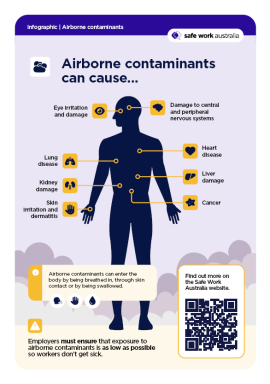
Downloads
Australia is transitioning to the Workplace exposure limits for airborne contaminants (WEL list). Until 1 December 2026, you must still comply with the Workplace exposure standards for airborne contaminants (WES list). Contact your work health and safety regulator for further information.
Infographic content:
Airborne contaminants can cause…
- Eye irritation and damage
- Damage to central and peripheral nervous systems
- Lung disease
- Heart disease
- Kidney damage
- Liver damage
- Skin irritation and dermatitis
- Cancer
Airborne contaminants can enter the body by being breathed in, through skin contact or by being swallowed.
Employers must ensure that exposure to airborne contaminants is as low as possible so workers don't get sick.
Additional Resources:
Publication Date:
Last updated:
Publication type:
